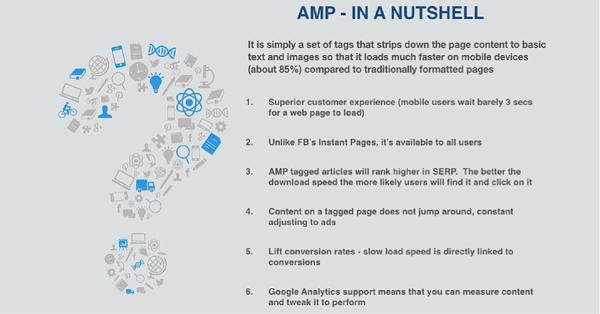
Late last year, Google announced the ‘Accelerated Mobile Pages Project’ (AMP), an open source initiative aimed at improving download speed of web pages on phones. It was the result of a collaboration between Google and 7 European publishers. After all, more web pages are being viewed on mobile devices than any other. So,
• What is AMP?
• Why is it important for you?
• And how will it impact your marketing?
What is AMP?
Most businesses have responsive sites or even websites specifically designed for mobile, but users are still frustrated by sites that load slowly or clog up their data connections. Data shows that users wait barely 3 seconds for content to load before abandoning a page.
AMP strips down the content to basics, such as important text and images, through a specific version of HTML called AMP HTML. For instance, it restricts the use of custom JavaScript. As a result, Google claims that AMP tagged pages could load up to 85% faster than traditionally formatted documents on a mobile device (explains the lightning bolt sign).

Why it may be important for you and the impact on marketing
While almost all big newsrooms in the world have AMP tagged content, it is a great development for anyone who publishes some form of online content (except maybe pure e-commerce players). That’s the reason scores of web publishers, including WordPress are now on board.
The improved mobile performance comes with obvious benefits:
• Superior customer experience improves the publisher/reader relationship
• Unlike Facebook’s Instant Articles, it’s available to the universe of users, not just a walled community.
For pure content players like news publishers, AMP pages are a fantastic development. But if you are any business with some static content pages, you should be adopting AMP for more that just download speed.
Here is why:
• The implication for SEO: AMP-enabled articles will rank higher in the SERPs (Search Engine Page Rankings). Page speed and mobile-readiness are high-quality ranking distinctions that will determine your page’s Google ranking. The better the speed, more likely that users will find and click on it.
• Customer Experience: Content on an AMP tagged page won’t jump around, resizing every time an ad jumps in and obscures content.
• Lift conversion rates: Slow load time is the prime reason for low conversions.
• Google Analytics Support: Last month, Google announced GA support for AMP tagged pages. That means it’s possible to measure content performance – It means you can create more targeted content that works.
And what are the negatives?
• AMP pages have a limited design range, and at this stage can only render simple layouts with limited fonts. No doubt this will change in future.
• Also, AMP is optimised for static content. So if you are a pure e-commerce player, a gaming site, etc. or have streaming content, then AMP is not for you.
AMP will continue to evolve. This is a good time to evaluate your website content and see if it’s for you.

